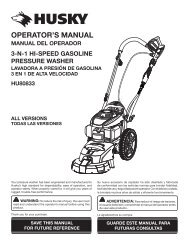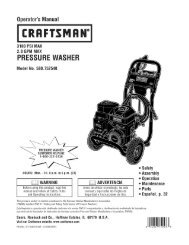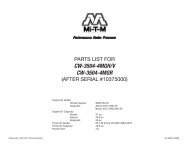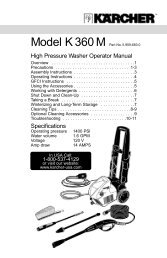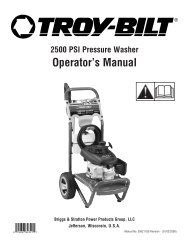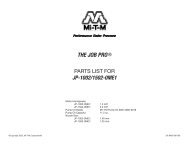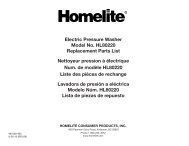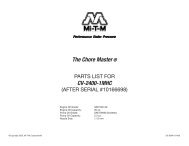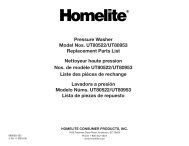English Instruction Manual - Simoniz
English Instruction Manual - Simoniz
English Instruction Manual - Simoniz
Create successful ePaper yourself
Turn your PDF publications into a flip-book with our unique Google optimized e-Paper software.
Use and Care Guide<br />
039-8563-8<br />
GAS Pressure Washer<br />
Congratulations on the purchase of your new pressure<br />
washer. In order to ensure you have the best possible<br />
experience please read through the following instructions.<br />
If you require any help please contact the customer service<br />
department at:<br />
1-866-4SIMONIZ<br />
(1-866-474-6664)<br />
Contact us for assistance, we’re here to help.
Table of Contents<br />
1. Safety Advice..........................................................................................................3<br />
1.1 Definitions..........................................................................................................3<br />
1.2 Safety Warnings................................................................................................3<br />
1.3 Intended Application..........................................................................................7<br />
2. Scope of Delivery....................................................................................................8<br />
3. Parts List...............................................................................................................10<br />
4. Assembly <strong>Instruction</strong>s......................................................................................... 12<br />
5. Engine Operation..................................................................................................14<br />
5.1 Adding/Checking Oil........................................................................................14<br />
5.2 Adding Fuel.....................................................................................................14<br />
5.3 Checking Air Filter...........................................................................................15<br />
5.4 Starting Engine................................................................................................15<br />
5.5 Stopping Engine..............................................................................................15<br />
6. Operating <strong>Instruction</strong>s...........................................................................................16<br />
6.1 Using Spray Nozzle.........................................................................................16<br />
6.2 Water Supply (Cold Water Only).....................................................................16<br />
6.3 Using Pressure Washer...................................................................................16<br />
6.4 Cleaning with Detergents................................................................................17<br />
6.5 Shutting Down and Cleaning Up.....................................................................17<br />
7. Cleaning and Maintenance...................................................................................17<br />
7.1 Cleaning Water Inlet Filter...............................................................................17<br />
7.2 Engine Maintenance........................................................................................18<br />
7.3 Cleaning the Spray Tips.................................................................................19<br />
7.4 Storing........................................................................................................... 19<br />
7.5 Winterizing Procedures...................................................................................20<br />
8. Technical Specifications........................................................................................20<br />
9. Troubleshooting....................................................................................................21<br />
10. Limited Warranty.................................................................................................23<br />
11. Explosion View....................................................................................................24
Safety Advice 3<br />
1. SAFETY ADVICE<br />
IMPORTANT, RETAIN FOR FU-<br />
TURE REFERENCE AND<br />
READ CAREFULLY!<br />
Do not attempt to install or operate this product<br />
until you have read the safety instructions in this<br />
manual. Safety items throughout this manual are<br />
labelled Danger, Warning, or Caution depending<br />
on the risk type.<br />
Read and understand the operating manual and<br />
labels on the product. Familiarize yourself with<br />
the product application and limitations and the<br />
specific potential hazards. Know the controls and<br />
their proper use. It is important to know how to<br />
stop the product and disengage the controls<br />
quickly.<br />
1.1 Definitions<br />
This is the safety alert symbol. It is used to<br />
alert you topotential personal injury hazards.<br />
Obey all safety messages thatfollow this symbol<br />
to avoid possible injury or death.<br />
DANGER<br />
Indicates an imminently hazardous situation which,<br />
if not avoided, will result in death or serious injury.<br />
WARNING<br />
Indicates a potentially hazardous situation which,<br />
ifnot avoided, could result in death or serious injury.<br />
CAUTION<br />
Indicates a potentially hazardous situation which, if<br />
not avoided, could result in minor or moderate injury.<br />
TOXIC GASES<br />
Alerts against possible toxic gases which can be<br />
harmful to your health or deadly if you are exposed<br />
to them.<br />
FLAMMABLE AND COMBUSTIBLE MA-<br />
TERIALS<br />
Alerts against the presence of materials/gases<br />
which can be extremely flammable.<br />
POISONOUS<br />
Alerts against materials/gases which are very poisonous<br />
and can cause serious bodily harm or even<br />
death.<br />
IMPORTANT<br />
Installation, operation, or maintenance information<br />
which is important but not hazard-related.<br />
1.2 Safety Warnings<br />
IMPORTANT<br />
Never operate this product under the following<br />
conditions:<br />
• If a noticeable change occurs in the engine speed<br />
• If the engine misfires<br />
• If there are flames or smoke in the area<br />
• If there are excessive vibrations<br />
DANGER<br />
Read all safety warnings and all instructions. Failure<br />
to follow the warnings and instructions may<br />
result in fire and/or serious injury.
4<br />
Safety Advice<br />
1.2 Safety DANGER–WORK Warnings AREA SAFETY AND<br />
EXHAUST FUMES<br />
• Keep work area clean and well lit. Cluttered and dark<br />
areas incite accidents.<br />
• Operate the product in a clean, dry and<br />
well-ventilated area.<br />
• Do not operate the product in explosive atmospheres,<br />
such as in the presence of flammable liquids,<br />
gases or dust. Power tools create sparks which may<br />
ignite the dust or fumes.<br />
• Never operate the product on a steep slope.<br />
• Keep children, pets, and bystanders away from the<br />
operating area. Breathing exhaust fumes can cause<br />
serious injury or even death.<br />
• Never start or run the engine indoors. The exhaust<br />
fumes are dangerous, containing carbon monoxide,<br />
an odorless and deadly gas. Operate this product<br />
only in a well-ventilated outdoor area.<br />
GASOLINE ENGINES PRODUCE<br />
TOXIC CARBON MONOXIDE EX-<br />
HAUST FUMES. BREATHING<br />
CARBON MONOXIDE CAN CAUSE<br />
NAUSEA, FAINTING, OR DEATH.<br />
WARNING–INADEQUATE VENTILATION<br />
• Materials placed against or near the product,<br />
or operating the product in areas where the<br />
ambient temperature exceeds 40 °C (104 °F)<br />
(such as storage rooms or garages) can interfere<br />
with its proper ventilation features, causing<br />
overheating and possible ignition of the materials<br />
or buildings.<br />
• Operate the product in a clean, dry, and<br />
well-ventilated area at least 2 m away from any<br />
buildings, objects, or walls.<br />
• NEVER OPERATE THIS PRODUCT INDOORS OR<br />
INPOORLY VENTILATED AREAS.<br />
WARNING–PERSONAL SAFETY<br />
• Stay alert, watch what you are doing, and use<br />
common sense when operating a pressure washer.<br />
Do not use a pressure washer while you are tired or<br />
under the influence of drugs, alcohol, or medication.<br />
moment of inattention while operating a pressure<br />
washer may result in serious personal injury.<br />
• Use safety equipment. Always wear eye protection.<br />
Protective equipment such as A dust mask, non-skid<br />
safety shoes, A hard hat, or hearing protection used<br />
for appropriate conditions will reduce personal injuries.<br />
• Do not use the product if the engine’s switch does<br />
not turn it on or off. Any gasoline powered product<br />
that cannot be controlled with the engine switch is<br />
dangerous and must be repaired.<br />
• Remove any adjusting key or wrench before starting<br />
the pressure washer. A wrench or a key left attached<br />
to a rotating part of the pressure washer may result in<br />
personal injury.<br />
• Do not overreach. Do not operate the product while<br />
barefoot or when wearing sandals or similar<br />
lightweight footwear. Wear protective footwear that<br />
will protect your feet and improve your footing on<br />
slippery surfaces. Do not stand on the product. Keep<br />
proper footing and balance at all times. This enables<br />
better control of the product in unexpected situations.<br />
• Avoid accidental starting. Be sure the engine’s switch<br />
is off before transporting the product or performing<br />
any maintenance or service on the unit. Transporting<br />
or performing maintenance or service on a product<br />
with its switch on invites accidents.<br />
• Dress properly. Do not wear loose clothing or jewellery.<br />
Keep your hair, clothing, and gloves away from<br />
moving parts. Loose clothes, jewellery, or long hair<br />
can get caught in moving parts.<br />
• Do not place your hands or feet near moving parts.<br />
• Do not use while on a ladder.<br />
CAUTION–HOT ENGINE AND MUFFLER<br />
THE ENGINE AND MUFFLER BECOME<br />
VERY HOT DURING AND AFTER USE.<br />
AVOID TOUCHING THE ENGINE OR<br />
THE MUFFLER DURING OR AFTER<br />
USE.
Safety Advice<br />
5<br />
1.2 Safety Warnings<br />
FLAMMABLE AND POISONOUS MATE-<br />
RIALS<br />
• Gasoline is highly flammable and its vapours can<br />
explode if ignited. Take precautions when using fuel<br />
to reduce the chance of serious personal injury.<br />
• When refilling or draining the fuel tank, use an approved<br />
fuel storage container while in a clean,<br />
well-ventilated outdoor area.<br />
• Do not smoke or allow sparks, open flames, or other<br />
sources of ignition near the area while adding fuel or<br />
operating the product. Never fill fuel tank indoors.<br />
• Equip the operating area with a fire extinguisher<br />
certified to handle gasoline or fuel fires.<br />
• Keep grounded conductive objects, such as tools,<br />
away from exposed, live electrical parts and connections<br />
to avoid sparking or arcing. These events could<br />
ignite fumes or vapours.<br />
• Always stop the engine and allow it to cool before<br />
filling the fuel tank. Never remove the cap of the fuel<br />
tank or add fuel while the engine is running or when<br />
the engine is hot. Do not operate the product with<br />
known leaks in the fuel system.<br />
• Loosen the fuel tank cap slowly to relieve any pressure<br />
in the tank.<br />
• Replace fuel tank and container caps securely and<br />
wipe up spilled fuel. Never operate the product<br />
without both caps securely in place.<br />
• Avoid creating a source of ignition for spilled fuel. If<br />
fuel is spilled, do not attempt to start the engine near<br />
spill. Move the product away from the area of spillage<br />
and avoid creating any source of ignition until fuel<br />
vapours have dissipated.<br />
• Store fue in containers specifically designed and<br />
approved for this purpose.<br />
• Store fuel in a cool, well-ventilated area, safely away<br />
from sparks, open flames, or other sources of ignition.<br />
• Never store fuel or product with fuel in the tank inside<br />
a building where fumes may reach a spark, open<br />
flame, or any other source of ignition, such as a water<br />
heater, furnace, clothes dryer, or the like. Allow<br />
the engine to cool before storing indoors.<br />
CAUTION–ENGINE SAFETY<br />
• Certain components in this product and its related<br />
accessories contain chemicals which are known to<br />
cause cancer, birth defects, or other reproductive<br />
harm. Wash hands after handling.<br />
• The engine exhaust from this product contains<br />
chemicals which are known to cause cancer, birth<br />
defects, or other reproductive harm.<br />
• Check fuel lines, tank, cap, and fittings frequently<br />
for cracks or leaks. Replace if necessary.<br />
• This engine was shipped without oil. Before you start<br />
the engine, make sure you add oil according to the<br />
instructions in this manual. If you start the engine<br />
without oil, it will be damaged beyond repair and will<br />
not be covered under the warranty.<br />
• When starting engine ensure that spark plug, muffler,<br />
fuel cap and air filter are in place and secured.<br />
• Do not crank engine with spark plug removed.<br />
• If engine floods, move the throttle control to fast position<br />
and crank until engine starts.<br />
• When operating the engine do not tip engine or<br />
equipment at an angle which will cause fuel to spill.<br />
• Do not choke the carburetor to stop the engine.<br />
• Never start or run the engine with the air cleaner<br />
assembly or the air filter removed.<br />
• Transport or move the product only with empty fuel<br />
tank.<br />
• Rapid retraction of starter cord (kickback) will pull<br />
hand and arm towards engine faster than you can let<br />
go. Risk of injury – broken bones, fractures, bruises,<br />
or sprains could result.<br />
• Keep the engine and muffle free of grass, leaves,<br />
excessive grease, or carbon build-up to reduce the<br />
chance of a fire hazard.<br />
• Do not tamper with any part of the engine to increase<br />
its speed.<br />
• If the product makes an unusual noise or vibration,<br />
immediately shut off the engine, disconnect the spark<br />
plug wire, and check for the cause. Unusual noise or<br />
vibration is generally a sign of a problem.<br />
• Use only attachments and accessories approved by<br />
the manufacturer. Failure to do so can result in personal<br />
injury.
6<br />
Safety Advice<br />
1.2 Safety Warnings<br />
CAUTION–SPECIFIC SAFETY ADVICE<br />
• Avoid dangerous conditions. Always operate this<br />
product on dry, solid and level ground.<br />
• Never operate this product on slippery, wet, muddy,<br />
or icy surfaces. The operating area should be free<br />
from any obstructions. There should be plenty of<br />
room for handling, and the operator should stay alert<br />
at all times.<br />
• Do not use this product in wet or damp areas or expose<br />
it to rain. Do not use it in areas where fumes<br />
from paint, solvents or flammable liquids pose a potential<br />
hazard.<br />
• Inspect this product. Check before turning it on.<br />
Keep guards in place and in working order. Form a<br />
habit of checking to see that keys and adjusting<br />
wrenches are removed from tool area before turning<br />
it on.<br />
• Replace damaged, missing or failed parts before<br />
using it. Make sure all nuts, bolts, screws, hydraulic<br />
fittings, hose clamps, etc. are securely tightened.<br />
Always check the oil level in the oil tank. Never operate<br />
this product when it needs to be repaired or<br />
when it is in poor mechanical condition.<br />
• Never move or pull this product while spraying.<br />
• Do not run the engine at a high speed when you are<br />
not using the product.<br />
• Risk of electric shock! The water spray<br />
must never be directed towards any electric<br />
wiring, devices, or directly towards the<br />
pressure washer itself, or fatal electric<br />
shock may occur.<br />
• Risk of injury! Do not direct the discharge<br />
stream at people. The<br />
high-pressure jet can be dangerous if misused,<br />
and therefore must not be directed<br />
at people, animals, electrical devices or<br />
the unit itself.<br />
• Risk of explosion! When a combustible liquid is<br />
sprayed, there can be danger of fire or explosion,<br />
especially in a closed area. Therefore, do not spray<br />
flammable liquids. Do not use acids and solvents<br />
with this product either. These products can cause<br />
physical injuries to the operator and irreversible<br />
damage to the product.<br />
• Learn how to stop the product and release the<br />
pressure quickly. Familiarize yourself with the controls.<br />
CAUTION–SPECIFIC SAFETY ADVICE<br />
• This product is capable of producing high pressure<br />
as rated in the Technical Specifications. To avoid<br />
rupture and injury, do not operate this product with<br />
components rated less than the unit itself (including<br />
but not limited to spray guns, hose, and hose<br />
connections).<br />
WARNING–INJECTION HAZARD<br />
• Equipment can cause serious injury if the spray<br />
penetrates the skin. Do not point the gun at anyone<br />
or any part of the body. In case of penetration, seek<br />
medical aid immediately.<br />
CAUTION–SPRAY GUN<br />
• The spray gun kicks back, so hold it with both<br />
hands.<br />
• The trigger gun safety lock prevents the trigger<br />
from being engaged accidentally and it should be<br />
placed in locked position when not in use.<br />
CAUTION–DETERGENTS<br />
• This product has been designed for use with detergents<br />
that are specifically approved for pressure<br />
washer use. The use of other cleaning detergents<br />
may affect the operation<br />
CAUTION–WATER CONNECTIONS<br />
• For use with fresh and clean water only. Do not use<br />
this product with other liquids.<br />
• To minimize the amount of water spraying back on<br />
the pressure washer, the device should be placed<br />
as far as possible from the cleaning site during use.<br />
• The water supply system must be protected<br />
against backflow.<br />
• Never use this product with water contaminated<br />
with solvents (e.g. paint thinners, gasoline, oil,etc.).<br />
• Always prevent debris from being drawn into the<br />
product by using a clean water source and an additional<br />
water filter, if required.<br />
• If this device is connected to a potable water system,<br />
the system must be protected against backflow.<br />
• Suitable water temperature: 5℃(41℉) to 40℃(104<br />
℉).
Safety Advice 7<br />
1.2 Safety Warnings<br />
CAUTION–SERVICE<br />
• Before cleaning, repairing, inspecting, or adjusting,<br />
shut off the engine and make sure that all moving<br />
parts have stopped.<br />
• Have your product serviced by certified repair personnel<br />
using only identical replacement parts. This<br />
ensures the safety of the product is maintained.<br />
• Ensure proper maintenance. Check for misalignment<br />
or binding of moving parts, breakage of parts<br />
and any other condition that may affect the product’<br />
s operation. If damaged, have the product repaired<br />
before use. Many accidents are caused by poorly<br />
maintained equipment.<br />
IMPORTANT–COLD WEATHER START<br />
• Do not operate this pressure washer in temperatures<br />
below 5℃. Operating pressure washer below<br />
5℃ may cause damage to the pump and other<br />
pressure washer parts.<br />
IMPORTANT–SAFETY FEATURES<br />
• Thermal Relief Valve: Protects the pump from<br />
overheating in case the nozzle gets clogged. This<br />
system should not be abused. Make sure the pump<br />
does not overheat.<br />
• Low-Oil Auto Shut-Off: Protects the engine and<br />
prevents operating without proper lubrication. If the<br />
engine oil level goes below the recommended level,<br />
the pressure washer shuts off automatically.<br />
CAUTION–PREVENT PUMP DAMAGE<br />
• Do not run the engine for more than 5 minutes<br />
without pressing the wand trigger or damage to the<br />
pump might occur.<br />
• Never let the engine run unless the product is connected<br />
to a water supply. Ensure water is running<br />
through the pressure washer before attempting to<br />
start the engine.<br />
• Never run caustic fluids or acid through this product.<br />
IMPORTANT–STORAGE<br />
• Store the product in a well-ventilated area, with an<br />
empty fuel tank. Fuel should never be stored or<br />
placed near the product.<br />
• When storing the product for winter, ensure that it is<br />
stored indoors (at room temperature), in a dry location<br />
away from any heat or ignition sources.<br />
• If the product is to be stored with fuel in the fuel<br />
tank, add a fuel stabilizer (Product # 38-0907-6) to<br />
keep the gas from breaking down.<br />
• To protect and extend the life of the product when<br />
storing it, use an antifreeze agent (Product #<br />
039-8602) for the pump, which can be found at your<br />
local Canadian Tire store.<br />
1.3 Intended Application<br />
This product is designed for specific residential applications.<br />
Do not modify or use this product for any<br />
application other than the one it was designed for.<br />
Doing so will void the warranty.<br />
This equipment was not designed for industrial use.<br />
Please refer to the icons below for suggested applications.<br />
For questions regarding other uses, please refer<br />
to our website at www. simoniz.ca or call us at<br />
1-866-4SIMONIZ (1-866-474-6664).<br />
IMPORTANT – APPLICATIONS<br />
STAIRS LAWN EQUIPMENT VEHICLE<br />
FENCING DECK OR PATIO GARAGE FLOOR<br />
DRIVEWAY SECOND STORY SIDING<br />
PAINT PREP
8<br />
Scope of Delivery<br />
2. SCOPE OF DELIVERY<br />
Ref. Description Qty. Visual<br />
A Main Frame 1<br />
B Wheel with Axle 2<br />
C<br />
Handle & Panel with 5 nozzles<br />
attached<br />
1<br />
D Spray Gun with Metal Wand 1<br />
E High-Pressure Hose (25ft) 1<br />
F Lower Gun Holder 1<br />
G Upper Gun Holder 1<br />
H Hose Hook 1<br />
I Square Neck Bolt 2<br />
J Securing Nut 2
Accessory Kit<br />
Scope of Delivery 9<br />
2. SCOPE OF DELIVERY<br />
Ref. Description Qty. Visual<br />
K<br />
L<br />
Bolt,Nut<br />
Water Inlet Filter<br />
1sets<br />
1<br />
M<br />
Spray Tip Cleaner 1<br />
N Spark Plug Wrench 1<br />
O Screwdriver 1<br />
P<br />
Spare O-Rings<br />
(2 for high pressure hose, 1 for<br />
quick-connector)<br />
3<br />
Q Wrench 1<br />
R Oil funnel 1
10<br />
Parts List<br />
3. PARTS LIST
Parts List 11<br />
3. PARTS LIST<br />
Ref. Description Ref. Description<br />
1 Spray Nozzles (x5) 10 Detergent Tank<br />
2 Trigger Safety Lock 11 Detergent Tank Caps<br />
3 Spray Gun with Wand 12 Air Filter<br />
4 Start Cord Handle 13 Water Outlet for Pressure Hose<br />
5 Muffler 14 Pump Detergent Inlet<br />
6 Oil Tank with Dipstick 15 Engine I/O Switch<br />
7 Spark Plug 16 Fuel Tank<br />
8 Pump Fresh Water Inlet 3/4” 17 Fuel Tank Cap<br />
9 Pump Unit 18 Pressure Hose(25ft)<br />
Note: Engine oil is not included. Always use oil type SAE 10W-30.
12<br />
Assembly <strong>Instruction</strong><br />
4. ASSEMBLY INSTRUCTIONS<br />
Letters refer to Scope of Delivery diagrams on pages 8 and 9.<br />
1<br />
2<br />
Lift the main frame (A) with one hand and attach<br />
one of the wheels (B) by pressing the<br />
wheel’s pin and inserting the wheel shaft into<br />
the main frame (A). Align the pin with the hole<br />
on the frame (A) until it snaps in. Repeat this<br />
procedure for the second wheel (B) on the opposite<br />
side.<br />
3<br />
Insert upper gun holder (G) to the groove of<br />
handle assembly(C) until the end as per instruction.<br />
Position handle assembly (C) and main frame<br />
(A) as per instruction and connect them by<br />
square neck bolt (I), then secure by nut (J).<br />
Repeat this procedure for the second on the<br />
opposite side.BE SURE to secure the nut to<br />
make the handle upright.
Assembly <strong>Instruction</strong> 13<br />
4. ASSEMBLY INSTRUCTIONS<br />
4<br />
6<br />
Insert hose hook (H) to the groove of handle<br />
assembly(C) until the end as per instruction.<br />
5<br />
Insert the water inlet filter (L) into the pump<br />
fresh water inlet (8). Then attach a garden hose<br />
or other means of water supply (not provided)<br />
to the pump inlet (8).<br />
The water flow rate must not fall below 18 litres<br />
per minute LPM (4 gallons per minute GPM), or<br />
the pump might be damaged.<br />
Note: please make sure all the quick connectors<br />
are connected in the right direction.<br />
7<br />
Insert the lower gun holder (F) to the position<br />
on frame as per instruction and then insert the<br />
bolt (K),screw the nut on the opposite position<br />
and secure by cross screwdriver (O) and<br />
wrench(Q)..<br />
Assemble the spray gun with the metal wand<br />
(3). Pull back the rubber piece to expose the<br />
threaded fitting. Then, screw the two pieces<br />
together and move the rubber piece back.
14<br />
Assembly <strong>Instruction</strong><br />
4. ASSEMBLY INSTRUCTIONS<br />
8<br />
Attach one end of the pressure hose (18) to the spray gun (3) .Take down the air shield on pump<br />
water outlet (13), then attach to the other end of the pressure hose and fasten.<br />
Note: please make sure all the quick connectors are connected in the right direction.<br />
Now your pressure washer is fully assembled.<br />
CAUTION<br />
Do not operate the product before you read and<br />
fully understand next chapter→Engine operation.
Engine Operation 15<br />
5. ENGINE OPERATION<br />
5.1 Adding/Checking Oil<br />
IMPORTANT<br />
Oil has been drained for shipping. Failure to fill engine<br />
with oil before starting engine will result in permanent<br />
damage and will void engine warranty. Add<br />
oil according to the instructions.<br />
WARNING<br />
• Always check the oil level before starting the engine,<br />
making sure the pressure washer is on a level<br />
surface.<br />
• Always use oil type SAE 10W30, which can be<br />
found at your local Canadian Tire store (Product #<br />
28-9301-6).<br />
1. Remove oil tank dipstick (6) and wipe it with<br />
a clean cloth.<br />
2. Replace and retighten the dipstick (6).<br />
3. Remove the dipstick (6) again and check the<br />
oil level. It should be at the top of the full indicator<br />
on the dipstick.<br />
4. If low, add oil slowly into the oil tank. Do not<br />
overfill. After adding oil, wait one minute and<br />
then recheck the oil level.<br />
5. Replace and retighten the dipstick (6).<br />
Tip: when adding oil use provided oil funnel (R).<br />
5.2 Adding Fuel<br />
WARNING<br />
• Make sure there is enough fuel in the fuel tank<br />
fore operating the pressure washer.<br />
• Use only clean, fresh, unleaded fuel. Use a minimum<br />
of 87 octane/87 AKI (91 RON).<br />
• Do not use old gas, and do not mix oil with gasoline.<br />
• Fuel and its vapours are extremely flammable and<br />
explosive. Fire or explosion can cause severe<br />
burns or death.<br />
1. Stop the engine (→Stopping Engine) and let<br />
it cool at least 2 minutes before removing the<br />
fuel tank cap (17).<br />
2. Clean the fuel cap area of dirt and debris.<br />
Remove the fuel tank cap (17) and make<br />
sure the fuel filter is in place.<br />
3. Fill the fuel tank (16) with fuel. Never overfill<br />
the fuel tank. Fill tank to no more than 13 mm<br />
below the bottom of the filler neck to provide<br />
space for expansion caused by the engine<br />
heat. To allow for expansion of the fuel, do<br />
not fill above the bottom of the fuel tank neck.<br />
4. Reinstall the fuel tank cap (17).<br />
2<br />
1<br />
FUEL TANK CAPACITY: 1L<br />
OIL TANK CAPACITY: 0.6L<br />
IMPORTANT<br />
• Keep fuel away from sparks, open flames, pilot<br />
lights, heat, and other ignition sources.<br />
• Check fuel hoses, tank, caps, and fittings frefor<br />
cracks or leaks. Replace if necessary.<br />
• If fuel spills, wait until it evaporates before starting<br />
engine.<br />
• Fill the fuel tank outdoors or in well-ventilated
16<br />
Engine Operation<br />
5. ENGINE OPERATION<br />
5.1 Adding/Checking Oil<br />
IMPORTANT<br />
Clean air filter (12) element for every 50 hours of use<br />
(every 10 hours under dusty conditions). Wash in<br />
high flashpoint solvent, squeeze dry, dip in clean engine<br />
oil, and squeeze out excess oil.<br />
IMPORTANT<br />
Before each use:<br />
• Check the oil and fuel level and fill if necessary.<br />
• Make sure that spark plug, muffler, fuel cap, and air<br />
filter are in place and secured.<br />
• Do not crank engine with spark plug removed.<br />
3<br />
1. Set the engine I/O switch (15) to I position.<br />
2. Pull the starter cord handle (17) slowly until<br />
resistance and then pull rapidly to avoid<br />
kickback.<br />
Press the two clips hard, and pull out the air filter<br />
element (12) and then wash it with clean water. Next,<br />
soak the filter in engine oil, and then squeeze the oil<br />
out. Place the air filter (5) back and re-clip the air filter<br />
cover.<br />
5.2 Starting Engine<br />
IMPORTANT<br />
If you have problems starting the pressure washer,<br />
call the <strong>Simoniz</strong> toll-free number at 1-866-4SIMONIZ<br />
(1-866-474-6664) and one of our customer service<br />
representatives will be glad to assist you.<br />
CAUTION<br />
Return the starter cord handle (17) gently to its starting<br />
position to prevent damage to the starter or the<br />
housing.<br />
5.3 Stopping Engine<br />
• To stop the engine set the engine I/O switch<br />
(15) to O position.
Operation <strong>Instruction</strong>s 17<br />
6. OPERATION INSTRUCTIONS<br />
6.1 Using Spray Nozzle<br />
This pressure washer comes with 5 different<br />
nozzles (1) that can be installed on the stainless<br />
steel wand (11).<br />
The spray pattern is adjusted by installing the<br />
appropriate spray nozzle (1).<br />
0°(red): thin and powerful stream of water for<br />
difficult stains and debris removal<br />
15°(yellow): thin-angled spray for detailed<br />
cleaning<br />
25°(green): medium-angled spray for detailed<br />
cleaning<br />
40°(white): large pattern for wider cleaning<br />
applications<br />
Detergent (black): this nozzle must be used<br />
together with a cleaning detergent at a low<br />
pressure. Use only this nozzle when using a<br />
detergent.<br />
Installing spray nozzle to the quick-connect<br />
coupler:<br />
6.3 Using Pressure Washer<br />
• Start the engine (→Starting Engine).<br />
• Install appropriate spray nozzle (1).<br />
• Release the trigger safety lock (2) if it is<br />
locked.<br />
• Purge the air by squeezing the trigger on the<br />
gun until there is a steady stream of water.<br />
• Position the tip of the wand (3) 15-20 cm<br />
(6-8”) away from the surface to be cleaned, at<br />
an angle appropriate to the spray nozzle used<br />
(0°, 15°, 25° or 40°).<br />
WARNING–NJECTION HAZARD<br />
• Pressure washer can cause serious injury if the<br />
spray penetrates the skin. Do not point the gun at<br />
anyone or any part of the body. In case of penetration,<br />
seek medical aid immediately.<br />
Pull the coupler ring back and insert the desired nozzle<br />
(1).<br />
Release the coupler ring to lock it back in place.<br />
6.2 Water Supply (Cold Water Only)<br />
• The unit must be used with cold water supply<br />
only. The water hose must be at least 13 mm<br />
(1/2”) in diameter.<br />
• The water flow rate must not fall below 18<br />
litres per minute LPM (4 gallons per minute<br />
GPM), or the pump might be damaged. The<br />
flow rate can be determined by running water<br />
for one minute into an empty container.<br />
• The water supply temperature must not exceed<br />
40℃(104℉).<br />
WARNING–DEPRESSURIZED<br />
• After cleaning is completed turn off the water<br />
supply and pull the trigger to depressurize the unit.<br />
Failure to do so might result in personal injury due<br />
to discharge of high-pressure water.
18<br />
Operating <strong>Instruction</strong>s/Cleaning and Maintenance<br />
6. OPERATION INSTRUCTIONS<br />
6.4 Cleaning with Detergents<br />
IMPORTANT<br />
This pressure washer is intended for use with special<br />
pressure washer detergents only. Do not use powdered<br />
soaps, which would clog the injection system.<br />
Follow the detergent manufacturer’s directions or call<br />
the <strong>Simoniz</strong> toll-free number at 1-866-4SIMONIZ<br />
(1-866-474-6664) if you have any questions or concerns.<br />
IMPORTANT<br />
Working with a detergent ensures quick soaking of<br />
the dirt, and allows the high-pressure water to penetrate<br />
and remove the dirt more effectively. Always<br />
spray detergent on a dry surface, do not presoak the<br />
area. Soaking the surface dilutes the detergent and<br />
reduces its cleaning ability.<br />
• When using detergent always use black detergent<br />
nozzle.<br />
• Pour detergent into detergent tanks (10).<br />
• The liquid detergent will be mixed with water<br />
automatically, being discharged through the<br />
detergent nozzle at a low pressure.<br />
• Allow detergent to remain on the surface for a<br />
short time before rinsing. Do not allow detergent<br />
to dry on the surface.<br />
• Rinse with clean water under high pressure.<br />
WARNING<br />
Damage may occur to painted surfaces if chemicals<br />
(detergents) are allowed to dry on them. Wash and<br />
rinse a small section at a time. Avoid working on hot<br />
surfaces or under direct sunlight.<br />
6.5 Shutting Down and Cleaning Up<br />
1. Skip step two if you are not using detergent.<br />
2. After cleaning with detergent, fill the detergent<br />
tank (10) with clean water. Spray water<br />
at a low pressure for one minute, so that all<br />
detergent is flushed out of the system.<br />
3. Stop the engine (→ Stopping Engine).<br />
4. Turn off the water supply and disconnect the<br />
water supply from the water inlet (8).<br />
5. Pull the gun trigger to release any remaining<br />
water pressure.<br />
6. Engage the trigger safety lock (2) on the<br />
spray gun (3) and rest the gun on lower and<br />
upper supports (F).<br />
WARNING<br />
Turn off the water supply and pull the trigger to depressurize<br />
the unit. Failure to do so might result in<br />
personal injury due to discharge of pressurized water.<br />
7. CLEANING AND MAINTENANCE<br />
7.1 Cleaning Water Inlet Filter<br />
• This pressure washer is equipped with a<br />
water inlet filter (L).<br />
• The water inlet filter (L) must be kept clean<br />
at all times, otherwise it can restrict the water<br />
flow to the pump unit (9) and damage it.<br />
• Remove the quick-connect coupler from the<br />
water inlet, then remove and clean the water<br />
inlet filter (L).
Cleaning and Maintenance 19<br />
7. CLEANING AND MAINTENANCE<br />
WARNING<br />
DO NOT operate this pressure washer without the<br />
water inlet filter in place, as deposits could build up<br />
internally and affect the functioning of the unit.<br />
7.2 Engine Maintenance<br />
Draining Engine Oil<br />
The engine oil should be replaced after the first<br />
20 hours of operation, or after the first month of<br />
use. After that, it should be replaced every 100<br />
hours or every 6 months.<br />
To drain the engine oil:<br />
1. Loosen the oil tank dipstick (6).<br />
2. Place an oil container underneath the opening<br />
on the main frame (A).<br />
3.Tilt the machine slowly and let oil drain out<br />
from drain hole.<br />
4. Once the oil has been completely drained,<br />
reposition the machine.<br />
Inspecting, Replacing or Cleaning the Spark<br />
Plug<br />
The spark plug should be checked every 100<br />
hours of operation or every 6 months.<br />
To replace or clean the spark plug:<br />
1. Disconnect the spark plug wire by pulling it<br />
off the spark plug.<br />
2. Using provided spark plug wrench (N), remove<br />
the spark plug by turning it counter-clockwise.<br />
If there is a carbon sediment<br />
build-up, remove it. If there is too much carbon<br />
sediment, replace the spark plug.<br />
Recommended Engine Oil<br />
Add oil as described in chapter → Adding/Checking<br />
Oil.<br />
IMPORTANT<br />
Used oil is a hazardous waste product and must be<br />
disposed of properly. Do not discard with household<br />
waste. Check with your local authorities, service<br />
center, or Canadian Tire19 for safe disposal/ recycling<br />
facilities.
20<br />
Cleaning and Maintenance<br />
7. CLEANING AND MAINTENANCE<br />
3. Check the gap with a wire gauge. If necessary,<br />
reset the gap to 0.7-0.8 mm. Install and<br />
tighten the spark plug to the recommended<br />
torque–180 lb-in (20 Nm).<br />
4. Reinstall the spark plug wire and protection<br />
cage in reverse order.<br />
7.4 Storing<br />
Store idle product out of the reach of children<br />
and do not allow persons unfamiliar with the<br />
product or these instructions to operate it. This<br />
product is dangerous in the hands of untrained<br />
users. Cover and store indoors, in a dry,<br />
well-ventilated area, such as a tool-shed.<br />
Long term storage of the pressure washer requires<br />
additional preventive measures to protect<br />
it against deterioration.<br />
1. Fuel<br />
• .Try to use up the fuel before storage.<br />
2. Add fuel stabilizer<br />
• If you do not wish to drain the fuel tank (16),<br />
add a fuel stabilizer into the fuel tank (16). Run<br />
the engine at least five minutes after adding<br />
the stabilizer to distribute it inside the fuel<br />
system.<br />
Note: In some areas, local law requires using a<br />
resistor spark plug to suppress ignition signals.<br />
If this engine was originally equipped with a<br />
resistor spark plug, use the same type for replacement.<br />
7.3 Cleaning the spray tips<br />
WARNING<br />
Clogging of the spray tip increases the water pressure<br />
and might damage the pump unit (19).<br />
3. Drain oil<br />
• Drain the oil (→ Draining Engine Oil).<br />
• Remove the spark plug.<br />
• Pour one tablespoon of oil through the spark<br />
plug hole–type 10W30.<br />
• Clean the spray tip by carefully inserting the<br />
provided spray tip cleaner (M), or a thin, sharp<br />
object (e.g., paper clips) into the tip to remove<br />
deposits.
Cleaning and Maintenance/Technical Specifications 21<br />
7. CLEANING AND MAINTENANCE<br />
• Make sure the engine I/O switch (15) is set to<br />
O position. Slowly pull the starter cord handle<br />
(4) until you feel tension, which indicates the<br />
piston is on its compression stroke and leave it<br />
in this position.<br />
• Replace the spark plug.<br />
7.5 Winterizing Procedures<br />
IMPORTANT<br />
• If the pressure washer is to be stored with gasoline<br />
in the fuel tank and carburetor, it is important to reduce<br />
the hazard of gasoline vapor ignition.<br />
• Select a well-ventilated storage area away from any<br />
appliance that operates with a flame, such as a<br />
furnace, water heater, or clothes dryer. Also avoid<br />
any area with a spark-producing electric motor, or<br />
where power tools are operated.<br />
• If possible, avoid storage areas with high humidity,<br />
because that promotes rust and corrosion.<br />
• Place the pressure washer on a level surface. Tilting<br />
can cause fuel or oil leakage.<br />
• Do not use plastic sheets as a dust cover. A nonporous<br />
cover will trap moisture around the pressure<br />
washer, promoting rust and corrosion.<br />
8. TECHNICAL SPECIFICATIONS<br />
• Pressure washer might be damaged if subjected<br />
to freezing temperatures. This type of<br />
damage is not covered by the limited warranty.<br />
To avoid possible damages, use a small<br />
amount of antifreeze.<br />
• Place the pressure washer on its side, with<br />
the water inlet (8) facing upwards, and pour<br />
1/4 cup of antifreeze into the water inlet (8).<br />
• Make sure the engine I/O switch (15) is set to<br />
O position and pull the starter cord handle (4)<br />
several times to distribute the antifreeze inside<br />
the pump system.<br />
• When taking the pressure washer out of storage,<br />
run water through the system until it runs<br />
clear.<br />
Maximum Pressure<br />
Rated Water Pressure<br />
Maximum Water Flow<br />
Minimum Inlet Pressure<br />
Maximum Inlet Pressure<br />
Pump Type<br />
Thermal Relief Valve<br />
Detergent Tank (Volume)<br />
Maximum Temperature<br />
of Pumped Water<br />
Engine Power (OHV)<br />
No Load Speed<br />
High Pressure Hose<br />
Length<br />
Inlet & Discharge Ports<br />
Displacement<br />
Net Weight<br />
Oil Type<br />
Oil Capacity<br />
Fuel Type<br />
Fuel Tank<br />
2600 PSI<br />
2000 PSI<br />
8 litres per minute<br />
LPM (2.1 gallons<br />
per minute GPM)<br />
30 PSI<br />
100 PSI<br />
Heavy-duty maintenance<br />
free axial<br />
cam<br />
Included<br />
2.5 L (0.66 Gal)<br />
40℃ (104℃)<br />
5.5 HP<br />
3600 RPM<br />
7.6m (25')<br />
13 mm (3/4")<br />
standard garden<br />
hose connector<br />
173 (cc)<br />
31.5 kg (69.4 lbs)<br />
SAE 10W30<br />
0.6 L<br />
Unleaded Gasoline<br />
1 L
22<br />
Troubleshooting<br />
9. TROUBLESHOOTING<br />
NOTE: If your unit still is not functioning properly once you have used this guide please call the<br />
SIMONIZ toll-free service number at 1-866-4SIMONIZ (1-866-474-6664). Please do NOT bring the<br />
unit back to the store until you have called this number.<br />
Engine<br />
PROBLEM POSSIBLE CAUSE SOLUTION<br />
Engine doesn’t<br />
start or difficult to<br />
start<br />
Engine stops after<br />
starting<br />
Engine lacks of<br />
power<br />
Engine stops<br />
while moving<br />
or being tiled<br />
Carburetor leaks<br />
Starter rope<br />
doesn't recoil<br />
Engine sounds<br />
abnormal or<br />
overloaded<br />
The engine power switch is OFF<br />
(o) position<br />
No fuel<br />
Low oil shut down sensor tripped<br />
to protect engine (not applicable<br />
to SKU#199-1010-8 2600 psi<br />
pressure washer)<br />
Excess water pressure in pump<br />
or hose<br />
Choke lever not in right position<br />
Clogged carburetor<br />
Carbon build-up on spark plug<br />
Incorrect starting method<br />
Low oil or no fuel<br />
Choke lever in Close position<br />
Clogged air filter<br />
Clogged carburetor<br />
Low oil shut down sensor tripped<br />
to protect engine (not applicable<br />
to SKU#199-1010-8 2600 psi<br />
pressure washer)<br />
Carburetor is clogged<br />
Recoil mechanism is broken<br />
RPM too low (not applicable to<br />
SKU#199-1010-8 2600 psi<br />
pressure washer)<br />
Clogged nozzle<br />
Pressure is too high<br />
Ensure the switch is in ON (I) position<br />
Fill the fuel tank with regular gasoline<br />
Add oil until it reaches minimum level on<br />
dip stick<br />
Release water pressure by squeezing<br />
trigger on gun<br />
1. When cold starting the engine, set the<br />
choke to CLOSE or OFF.<br />
2. When warm starting, set the choke to<br />
OPEN or ON or try the middle position.<br />
Clean the carburetor. Refer to the instruction<br />
manual<br />
Clean the spark plug. Refer to the instruction<br />
manual<br />
Use correct starting method. Refer to<br />
the instruction manual<br />
Check oil and fuel levels<br />
Move the choke lever to Open position<br />
immediately after starting the engine<br />
Clean or replace the air filter. Refer to<br />
the instruction manual<br />
Clean the carburetor. Refer to the instruction<br />
manual<br />
Do not tilt the machine past 15⁰ when<br />
operating. Check oil level and ensure it<br />
is above the minimum level on the dip<br />
stick<br />
Clean the carburetor. Refer to the instruction<br />
manual<br />
CALL Customer Service Toll-Free<br />
Adjust throttle lever to Fast position<br />
Clean nozzle with tip cleaner<br />
CALL Customer Service Toll-Free
Troubleshooting 23<br />
Pump<br />
Accessories<br />
&<br />
Connections<br />
PROBLEM POSSIBLE CAUSE SOLUTION<br />
No pressure, low<br />
pressure<br />
Nozzle tip not attached<br />
Water supply faucet closed<br />
Water supply pressure is<br />
low<br />
Inlet water filter is clogged<br />
Air in pump<br />
The loaded RPM is not set<br />
to FAST (not applicable to<br />
SKU#199-1010-8 2600 psi<br />
pressure washer)<br />
Clogged check valve<br />
Damaged pump<br />
Attach required nozzle tip<br />
Turn on faucet. Ensure there are<br />
no kinks or blockage in hose<br />
Ensure faucet is fully opened.<br />
Check to make sure water<br />
supply is a minimum 30 psi, 4<br />
GPM<br />
Clean the water filter. Refer to<br />
the instruction manual<br />
Squeeze trigger to release the<br />
air in pump when the machine is<br />
running<br />
Set RPM (Throttle lever) to<br />
FAST position<br />
CALL Customer Service<br />
Toll-Free<br />
CALL Customer Service<br />
Toll-Free<br />
Pressure too high Clogged nozzle Clean nozzle with tip cleaner<br />
Water or oil leaks<br />
out of Pump<br />
Cold water keeps<br />
draining out of<br />
thermal relief valve<br />
No intake of detergent<br />
Damaged seal ring<br />
Defective thermal relief<br />
valve<br />
The detergent siphon tube<br />
is not connected<br />
Damaged detergent siphon<br />
tube<br />
Wrong nozzle<br />
Detergent adjustment knob<br />
set to wrong position<br />
Clogged nozzle<br />
Clogged pump detergent<br />
siphon fitting<br />
Detergent is too thick.<br />
Clogged detergent filter<br />
Only applies to<br />
SKU#199-1010-8 2600 psi<br />
CALL Customer Service<br />
Toll-Free<br />
CALL Customer Service<br />
Toll-Free<br />
Connect detergent siphon tube<br />
properly. Refer to the instruction<br />
manual<br />
Replace the detergent siphon<br />
tube<br />
Use black nozzle when applying<br />
detergent. Refer to the instruction<br />
manual<br />
Check adjustment knob. Refer to<br />
the instruction manual<br />
Clean nozzle<br />
Detach the detergent siphon<br />
tube and clean the fitting with tip<br />
cleaner<br />
Use only detergent approved for<br />
use with pressure washer<br />
Clean detergent filter
9. TROUBLESHOOTING<br />
pressure washer
24<br />
Troubleshooting/Limited Warranty<br />
9. TROUBLESHOOTING<br />
Accessories<br />
&<br />
Connections<br />
PROBLEM<br />
The trigger can’t be<br />
squeezed<br />
There is water leakage<br />
at joints/connections<br />
on gun, hose and/or<br />
pump<br />
High Pressure Hose<br />
can’t be connected to<br />
pump or gun<br />
POSSIBLE<br />
CAUSE<br />
Safety lock is not<br />
open<br />
Damaged seal<br />
ring<br />
The O rings are<br />
not lubricated<br />
SOLUTION<br />
Open the safety lock. Refer to the instruction<br />
manual<br />
Change with back-up O-ring or purchase<br />
accessory kit<br />
SKU#.039-8552-8 at local Canadian<br />
Tire Store ○R<br />
Put lubricating oil or water on the O<br />
rings<br />
10. LIMITED WARRANTY<br />
Always keep your receipt as proof of purchase.<br />
We’re here to help! If you have any questions or comments, call our toll-free hotline<br />
1‐ 866-4SIMONIZ (1-866-474-6664). Have your serial number ready. The serial number can be<br />
found on the back plate, located on the rear of the unit.<br />
This product has a Parts Replacement, Product Exchange and/or Repair Warranty only. NO RE-<br />
FUNDS will be provided. Please see stores for Product Exchange details.<br />
Two-(2)-Year Warranty-Motor<br />
This product is guaranteed to be free from defects in material and workmanship for two years from<br />
the date of its original purchase. If such a defect appears during the warranty period, upon presentation<br />
of proof of purchase, Trileaf Distribution will repair or replace the product (at its discretion).<br />
Shipping charges may apply.<br />
Ninety-(90)-Day Warranty – Accessories<br />
Trigger gun, hose, spray wands, and other accessories are guaranteed for ninety (90) days from<br />
the date of purchase. You may purchase accessories directly through the place of purchase, or by<br />
calling our toll-free hotline 1‐ 866-4SIMONIZ (1-866-474-6664).<br />
This warranty does not cover accidental damage, unreasonable use, normal wear and tear, use of<br />
improper detergents, freezing, neglect, or non-compliance with the Operating <strong>Instruction</strong>s. The<br />
warranty does not cover loss of use or other consequential damages arising from any of the<br />
above, nor does it cover repairs made or attempted by unauthorized persons.<br />
The warranty is void if the equipment is used for commercial, rental, or industrial purposes.<br />
If you have further questions, please visit our website (www.simoniz.ca) or call 1-866-4SIMONIZ<br />
(1-866-474-6664).<br />
Imported by Trileaf Distribution Trifeuil, Toronto, Canada M4S 2B8
11. EXPLOSION VIEW<br />
Explosion View 25
26<br />
Explosion View<br />
11. EXPLOSION VIEW<br />
Ref. Description Qty.<br />
1 Handle Foam 1<br />
2 Handle 1<br />
3 ST4×25 4<br />
4 Locknut M5 12<br />
5 Back Panel 1<br />
6 Hose Hook 1<br />
7 High Pressure Hose 1<br />
8 Plug 2<br />
9 Square Neck Bolt 2<br />
10 Securing Nut Assembly 2<br />
11 Frame 1<br />
12 Drain Pipe 1<br />
13 Air shield 1<br />
14 Gasoline Engine 1<br />
15 Washer 8 3<br />
16 Circlipφ8 1<br />
17 M8X40 1<br />
18 Circlipφ16 2<br />
19 Plain Washerφ16 2<br />
20 9”Wheel 2<br />
21 Wheel Shaft 2<br />
22 Spring Wire 2<br />
23 Circlip 2<br />
24 Spring Lock 2<br />
25 Injection Hose 1<br />
26 GQX-41F High Pressure Pump 1<br />
27 Thermal Relief 1<br />
28 LocknutM8 4<br />
Ref. Description Qty.<br />
29 Rubber Foot 2<br />
30 M8×45 2<br />
31 Rubber Foot Washer 2<br />
32 Inlet Hose 1<br />
33 Inlet Hose Nut 1<br />
34 Detergent Tank 1<br />
35 M5×40 6<br />
36 Lower Gun Holder 1<br />
37 M5×50 1<br />
38 Detergent Tank Cap 1<br />
39 M8×60 2<br />
40 Rope Guider 1<br />
41 Washer 5 1<br />
42 Padding Block 4<br />
43 Upper Gun Holder 1<br />
44 Gun Holder Connector 1<br />
45 M5×65 4<br />
1-46 0° Nozzle (red) 1<br />
2-46 15° Nozzle (yellow) 1<br />
3-46 25° Nozzle (green) 1<br />
4-46 40° Nozzle (white) 1<br />
5-46 Detergent Nozzle (black) 1<br />
47 Nozzle Grommet 5<br />
48 2#B Gun 1<br />
49 2#B Wand 1



